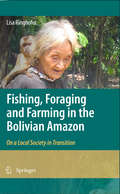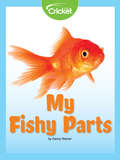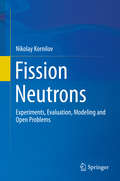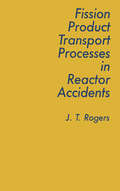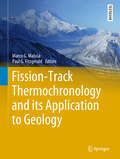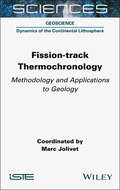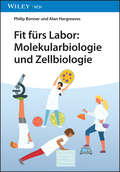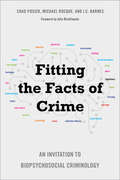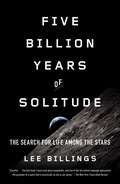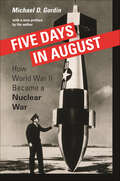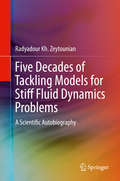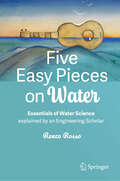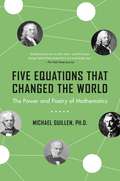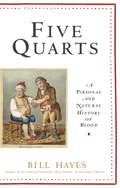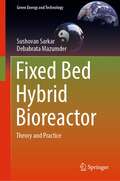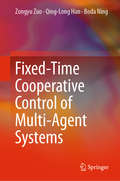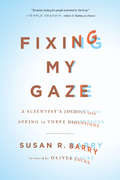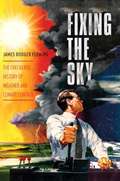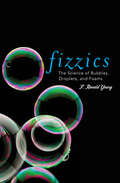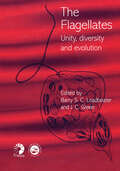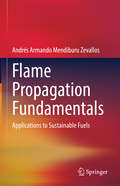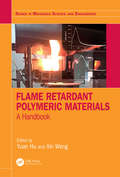- Table View
- List View
Fishing, Foraging and Farming in the Bolivian Amazon
by Lisa RinghoferEmpirical in character, this book analyses the society-nature interaction of the Tsimane', a rural indigenous community in the Bolivian Amazon. Following a common methodological framework, the material and energy flow (MEFA) approach, it gives a detailed account of the biophysical exchange relations the community entertains with its natural environment: the socio-economic use of energy, materials, land and time. Equally so, the book provides a deeper insight into the local base of sociometabolic transition processes and their inherent dynamics of change. The local community described in this publication stands for the many thousands of rural systems in developing countries that, in light of an ever more globalising world, are currently steering a similar - but maybe differently-paced - development course. This book presents insightful methodological and conceptual advances in the field of sustainability science and provides a vital reader for students and researchers of human ecology, ecological anthropology, and environmental sociology. It equally contributes to improving professional development work methods.
Fishy Parts
by Danny ResnerWe use our lungs to get oxygen from the air to breathe. Fish use their gills to get oxygen from water! Learn about the different body parts fish have and how they use them to live. Guess what body part helps the Salmon find its way home!
Fission Neutrons
by Nikolay KornilovAlthough the fission of heavy nuclei was discovered over 75 years ago, many problems and questions still remain to be addressed and answered. The reader will be presented with an old, but persistent problem of this field: The contradiction between Prompt Fission Neutron (PFN) spectra measured with differential (microscopic) experiments and integral (macroscopic and benchmark) experiments (the Micro-Macro problem). The difference in average energy is rather small ~3% but it is stable and we cannot explain the difference due to experimental uncertainties. Can we measure the PFN spectrum with high accuracy? How may we compare results of different experiments to provide better accuracy? Are our traditional theoretical models correct? What can be done to solve the Micro-Macro problem in future? These questions are discussed in this monograph for the reader. The current work will be of interest to graduate students and researchers, particularly those working in nuclear and neutron physics.
Fission Product Processes In Reactor Accidents
by J. T. RogersThe Three Mile Island and Chernobyl nuclear incidents emphasized the need for the world-wide nuclear community to cooperate further and exchange the results of research in this field in the most open and effective manner. Recognizing the roles of heat and mass transfer in all aspects of fission-product behavior in sever reactor accidents, the Executive Committee of the International Centre for Heat and Mass Transfer organized a Seminar on Fission Product Transport Processes in Reactor Accidents. This book contains the eleven of the lectures and all the papers presented at the seminar along with four invited papers that were not presented and a summary of the closing session.
Fission-Track Thermochronology and its Application to Geology (Springer Textbooks in Earth Sciences, Geography and Environment)
by Marco G. Malusà Paul G. FitzgeraldThis book is focused on the basics of applying thermochronology to geological and tectonic problems, with the emphasis on fission-track thermochronology. It is conceived for relatively new practitioners to thermochronology, as well as scientists experienced in the various methods. The book is structured in two parts. Part I is devoted to the fundamentals of the fission-track method, to its integration with other geochronologic methods, and to the basic principles of statistics for fission-track dating and sedimentology applied to detrital thermochronology. Part I also includes the historical development of the technique and thoughts on future directions. Part II is devoted to the geological interpretation of the thermochronologic record. The thermal frame of reference and the different approaches for the interpretation of fission-track data within a geological framework of both basement and detrital studies are discussed in detail. Separate chapters demonstrate the application of fission-track thermochronology from various perspectives (e.g., tectonics, petrology, stratigraphy, hydrocarbon exploration, geomorphology), with other chapters on the application to basement rocks in orogens, passive continental margins and cratonic interiors, as well as various applications of detrital thermochronology.
Fission-track Thermochronology: Methodology and Applications to Geology (ISTE Consignment)
by Marc JolivetLow-temperature thermochronology has become an essential tool when studying near-surface geological processes. Time-temperature constraints are vital to quantify and describe a large variety of geological processes, such as relief building, erosion and sedimentation or the maturation of organic matter in sedimentary basins. After a brief history covering the discovery of fission tracks to their first applications in geochronology, Fission-track Thermochronology presents a complete description of not only the fission-track, but also the (U Th Sm)/He thermochronology approaches, both on basement rocks and on sediments. Firstly, the physical and chemical processes that underlie these techniques are addressed, and the analytical methods are described in detail. A particular focus is placed on the latest developments, such as the use of laser-ablation ICP-MS, and a whole chapter is dedicated to statistical modeling of the data. Finally, numerous examples of applications to geological questions will provide the reader with a comprehensive overview of the possibilities of low temperature thermochronology in solving geological and geomorphological questions.
Fit fürs Labor: Molekularbiologie und Zellbiologie
by Alan J. Hargreaves Philip L.R. BonnerSouverän durchs Praktikum: Macht Studierende der Biologie, Biochemie oder Biotechnologie fit für die ungewohnte Arbeitsumgebung eines wissenschaftlichen Labors Fit fürs Labor: Molekularbiologie & Zellbiologie gibt Studierenden in den Biowissenschaften ein kompaktes Nachschlagewerk an die Hand, das alle wesentlichen molekularbiologischen und zellbiologischen Arbeitsmethoden erklärt. Von der Extraktion über die Aufreinigung zur Funktionsbestimmung von Nukleinsäuren und Proteinen, grundlegenden Zellkulturtechniken und immunchemischen Verfahren wird die Bandbreite biowissenschaftlicher Labortechniken abgedeckt. Zu einem erfolgreichen Laborversuch gehört auch die Vorbereitung des Versuchs und der dazu nötigen Materialien, die Dokumentation der gewonnenen Daten sowie deren Auswertung. Daher sind neben Schritt-für-Schritt-Erläuterungen zur Versuchsdurchführung zahlreiche Beispiel zur Analyse und Interpretation der aus dem Experiment gewonnenen Daten enthalten. Vom Ansetzen einer Stammlösung bis zur Durchführung eines biologischen Assays werden alle wichtigen Labortechniken erklärt Mehr als 40 Übungen und Beispielrechnungen sind enthalten, die die typischen Anforderungen und Aufgaben in einem Laborpraktikum abdecken Angereichert mit vielen hilfreichen Definitionen und kleinen Exkursen, die das Leben & Lernen leichter machen Mit Fit fürs Labor: Molekularbiologie und Zellbiologie kann jede und jeder ein biowissenschaftliches Laborpraktikum meistern!
Fitting the Facts of Crime: An Invitation to Biopsychosocial Criminology
by Chad Posick Michael Rocque J.C. BarnesBiosocial criminology—and biosocial criminologists—focuses on both the environmental and biological factors that contribute to antisocial behavior. Importantly, these two domains are not separate parts of an equation but pieces of the same puzzle that fit together for a complete picture of the causes of crime/antisocial behavior. Fitting the Facts of Crime applies a biopsychosocial lens to the “13 facts of crime” identified by John Braithwaite in his classic book, Crime, Shame and Reintegration. The authors unpack established facts—about gender and sex, age, environment, education, class, social bonds and associations, stress, and other influences—providing both empirical research and evidence from biopsychosocial criminology to address the etiology behind these facts and exactly how they are related to deviant behavior. With their approach, the authors show how biopsychosocial criminology can be a unifying framework to enrich our understanding of the most robust and well-established topics in the field. In so doing, they demonstrate how biological and psychological findings can be responsibly combined with social theories to lend new insight into existing inquiries and solutions. Designed to become a standard text for criminology in general, Fitting the Facts of Crime introduces key concepts and applies them to real-world situations.
Five Billion Years of Solitude
by Lee BillingsFrom science writer Lee Billings, an intimate history of Earth and the quest for life beyond the solar system.
Five Billion Years of Solitude
by Lee BillingsAn intimate history of Earth and the quest for life beyond the solar system For 4.6 billion years our living planet has been alone in a vast and silent universe. But soon, Earth's isolation could come to an end. Over the past two decades, astronomers have discovered thousands of planets orbiting other stars. Some of these exoplanets may be mirror images of our own world. And more are being found all the time. Yet as the pace of discovery quickens, an answer to the universe's greatest riddle still remains just out of reach: Is the great silence and emptiness of the cosmos a sign that we and our world are somehow singular, special, and profoundly alone, or does it just mean that we're looking for life in all the wrong places? As star-gazing scientists come closer to learning the truth, their insights are proving ever more crucial to understanding life's intricate mysteries and possibilities right here on Earth. Science journalist Lee Billings explores the past and future of the "exoplanet boom" through in-depth reporting and interviews with the astronomers and planetary scientists at its forefront. He recounts the stories behind their world-changing discoveries and captures the pivotal moments that drove them forward in their historic search for the first habitable planets beyond our solar system. Billings brings readers close to a wide range of fascinating characters, such as: FRANK DRAKE, a pioneer who has used the world's greatest radio telescopes to conduct the first searches for extraterrestrial intelligence and to transmit a message to the stars so powerful that it briefly outshone our Sun. JIM KASTING, a mild-mannered former NASA scientist whose research into the Earth's atmosphere and climate reveals the deepest foundations of life on our planet, foretells the end of life on Earth in the distant future, and guides the planet hunters in their search for alien life. SARA SEAGER, a visionary and iron-willed MIT professor who dreams of escaping the solar system and building the giant space telescopes required to discover and study life-bearing planets around hundreds of the Sun's neighboring stars. Through these and other captivating tales, Billings traces the triumphs, tragedies, and betrayals of the extraordinary men and women seeking life among the stars. In spite of insufficient funding, clashing opinions, and the failings of some of our world's most prominent and powerful scientific organizations, these planet hunters will not rest until they find the meaning of life in the infinite depths of space. Billings emphasizes that the heroic quest for other Earth-like planets is not only a scientific pursuit, but also a reflection of our own culture's timeless hopes and fears.
Five Days in August: How World War II Became a Nuclear War
by Michael D. GordinMost Americans believe that the Second World War ended because the two atomic bombs dropped on Japan forced it to surrender. Five Days in August boldly presents a different interpretation: that the military did not clearly understand the atomic bomb's revolutionary strategic potential, that the Allies were almost as stunned by the surrender as the Japanese were by the attack, and that not only had experts planned and fully anticipated the need for a third bomb, they were skeptical about whether the atomic bomb would work at all. With these ideas, Michael Gordin reorients the historical and contemporary conversation about the A-bomb and World War II.Five Days in August explores these and countless other legacies of the atomic bomb in a glaring new light. Daring and iconoclastic, it will result in far-reaching discussions about the significance of the A-bomb, about World War II, and about the moral issues they have spawned.
Five Decades of Tackling Models for Stiff Fluid Dynamics Problems
by Radyadour Kh. ZeytounianRationality - as opposed to 'ad-hoc' - and asymptotics - to emphasize the fact that perturbative methods are at the core of the theory - are the two main concepts associated with the Rational Asymptotic Modeling (RAM) approach in fluid dynamics when the goal is to specifically provide useful models accessible to numerical simulation via high-speed computing. This approach has contributed to a fresh understanding of Newtonian fluid flow problems and has opened up new avenues for tackling real fluid flow phenomena, which are known to lead to very difficult mathematical and numerical problems irrespective of turbulence. With the present scientific autobiography the author guides the reader through his somewhat non-traditional career; first discovering fluid mechanics, and then devoting more than fifty years to intense work in the field. Using both personal and general historical contexts, this account will be of benefit to anyone interested in the early and contemporary developments of an important branch of theoretical and computational fluid mechanics.
Five Easy Pieces on Water: Essentials of Water Science explained by an Engineering Scholar
by Renzo RossoWater is the essential substance for life on Earth. The natural patrimony of all living beings and the material and cultural heritage, a common good, a shared resource, a treasure trove of humanity. The nature of water, water at rest and in motion, the water cycle and its management are addressed here in a multidimensional, comprehensive and transdisciplinary approach. The book focuses on water without complying with any disciplinary approach: philosophical, historical, physical and mathematical issues are merged with traditional hydrochemistry, hydrostatics, hydrodynamics and hydrology to provide an overview of basic knowledge on Earth’s water. These five lectures can be delivered to any undergraduate STEM student to introduce them a valuable, basic, multidisciplinary knowledge on water. Non-specialists will find here an insight of water made as simple as possible, but not simpler than required
Five Equations That Changed the World: The Power and Poetry of Mathematics
by Michael GuillenA Publishers Weekly best book of 1995! Dr. Michael Guillen, known to millions as the science editor of ABC's Good Morning America, tells the fascinating stories behind five mathematical equations. As a regular contributor to daytime's most popular morning news show and an instructor at Harvard University, Dr. Michael Guillen has earned the respect of millions as a clear and entertaining guide to the exhilarating world of science and mathematics. Now Dr. Guillen unravels the equations that have led to the inventions and events that characterize the modern world, one of which -- Albert Einstein's famous energy equation, E=mc2 -- enabled the creation of the nuclear bomb. Also revealed are the mathematical foundations for the moon landing, airplane travel, the electric generator -- and even life itself. Praised by Publishers Weekly as "a wholly accessible, beautifully written exploration of the potent mathematical imagination," and named a Best Nonfiction Book of 1995, the stories behind The Five Equations That Changed the World, as told by Dr. Guillen, are not only chronicles of science, but also gripping dramas of jealousy, fame, war, and discovery.
Five Quarts: A Personal and Natural History of Blood
by Bill Hayes"We're born in blood. Our family histories are contained in it, our bodies nourished by it daily. Five quarts run through each of us, along some sixty thousand miles of arteries, veins, and capillaries."-from Five Quarts. In the national bestseller Sleep Demons, Bill Hayes took us on a trailblazing trip through the night country of insomnia. Now he is our guide on a whirlwind journey through history, literature, mythology, and science by means of the great red river that runs five quarts strong through our bodies. Profusely illustrated, the journey stretches from ancient Rome, where gladiators drank the blood of vanquished foes to gain strength and courage, to modern-day laboratories, where high-tech machines test blood for diseases and dedicated scientists search for elusive cures. Along the way, there will be world-changing triumphs: William Harvey's discovery of the circulation of the blood; Antoni van Leeuwenhoek's advances in making the invisible world visible in the early days of the microscope; Dr. Paul Ehrlich's Nobel-Prize-winning work in immunology; Dr. Jay Levy's codiscovery of the virus that causes AIDS. Yet there will also be ignorance and tragedy: the widespread practice of bloodletting via incision and the use of leeches, which harmed more than it healed; the introduction of hemophilia into the genetic pool of nineteenth-century European royalty thanks to the dynastic ambitions of Queen Victoria; the alleged spread of contaminated blood through a phlebotomist's negligence in modern-day California. This is also a personal voyage, in which Hayes recounts the impact of the vital fluid in his daily life, from growing up in a household of five sisters and their monthly cycles, to coming out as a gay man during the explosive early days of the AIDS epidemic in San Francisco, to his enduring partnership with an HIV-positive man. As much a biography of blood as it is a memoir of how this rich substance has shaped one man's life, Five Quarts is by turns whimsical and provocative, informative and moving. It will get under your skin.
Fixed Bed Hybrid Bioreactor: Theory and Practice (Green Energy and Technology)
by Sushovan SarkarThis book describes a simplified approach to the modelling and process design of a fixed bed hybrid bioreactor for wastewater treatment. In this work a simplified model for hybrid bioreactor is developed to determine output parameters like exiting substrate concentration in bulk liquid, average substrate flux in the biofilm, effective and total biofilm thickness. The model is based on mass balance of both carbonaceous substrate and biomass under suspended and attached growth simultaneously along with substrate mass transport into the biofilm. The proposed model has also been validated with the results obtained from experimental study with municipal wastewater considering as a low strength wastewater with no inhibition. There is a flexibility of the proposed model making it a versatile one to find out the exiting substrate concentration both in hybrid bioreactor as well as in a completely mixed biofilm reactor (CMBR). The book caters to academics and practitioners working in the field of advanced wastewater treatment.
Fixed-Time Cooperative Control of Multi-Agent Systems
by Qing-Long Han Zongyu Zuo Boda NingThis monograph presents new theories and methods for fixed-time cooperative control of multi-agent systems. Fundamental concepts of fixed-time stability and stabilization are introduced with insightful understanding. This book presents solutions for several problems of fixed-time cooperative control using systematic design methods. The book compares fixed-time cooperative control with asymptotic cooperative control, demonstrating how the former can achieve better closed-loop performance and disturbance rejection properties. It also discusses the differences from finite-time control, and shows how fixed-time cooperative control can produce the faster rate of convergence and provide an explicit estimate of the settling time independent of initial conditions. This monograph presents multiple applications of fixed-time control schemes, including to distributed optimization of multi-agent systems, making it useful to students, researchers and engineers alike.
Fixing My Gaze $ A Scientist's Journey Into Seeing in Three Dimensions: A Scientist's Journey Into Seeing in Three Dimensions
by Susan R. BarryWhen neuroscientist Susan Barry was fifty years old, she took an unforgettable trip to Manhattan. As she emerged from the dim light of the subway into the sunshine, she saw a view of the city that she had witnessed many times in the past but now saw in an astonishingly new way. Skyscrapers on street corners appeared to loom out toward her like the bows of giant ships. Tree branches projected upward and outward, enclosing and commanding palpable volumes of space. Leaves created intricate mosaics in 3D. With each glance, she experienced the deliriously novel sense of immersion in a three dimensional world. Barry had been cross-eyed and stereoblind since early infancy. After half a century of perceiving her surroundings as flat and compressed, on that day she was seeing Manhattan in stereo depth for first time in her life. As a neuroscientist, she understood just how extraordinary this transformation was, not only for herself but for the scientific understanding of the human brain. Scientists have long believed that the brain is malleable only during a “critical period” in early childhood. According to this theory, Barry’s brain had organized itself when she was a baby to avoid double vision – and there was no way to rewire it as an adult. But Barry found an optometrist who prescribed a little-known program of vision therapy; after intensive training, Barry was ultimately able to accomplish what other scientists and even she herself had once considered impossible. A revelatory account of the brain’s capacity for change, Fixing My Gaze describes Barry’s remarkable journey and celebrates the joyous pleasure of our senses.
Fixing the Sky
by Fleming James RodgerAs alarm over global warming spreads, a radical idea is gaining momentum. Forget cuts in greenhouse gas emissions, some scientists argue. Instead, bounce sunlight back into space by pumping reflective nanoparticles into the atmosphere. Launch mirrors into orbit around the Earth. Make clouds thicker and brighter to create a "planetary thermostat. "These ideas might sound like science fiction, but in fact they are part of a very old story. For more than a century, scientists, soldiers, and charlatans have tried to manipulate weather and climate, and like them, today's climate engineers wildly exaggerate what is possible. Scarcely considering the political, military, and ethical implications of managing the world's climate, these individuals hatch schemes with potential consequences that far outweigh anything their predecessors might have faced. Showing what can happen when fixing the sky becomes a dangerous experiment in pseudoscience, James Rodger Fleming traces the tragicomic history of the rainmakers, rain fakers, weather warriors, and climate engineers who have been both full of ideas and full of themselves. Weaving together stories from elite science, cutting-edge technology, and popular culture, Fleming examines issues of health and navigation in the 1830s, drought in the 1890s, aircraft safety in the 1930s, and world conflict since the 1940s. Killer hurricanes, ozone depletion, and global warming fuel the fantasies of today. Based on archival and primary research, Fleming's original story speaks to anyone who has a stake in sustaining the planet.
Fixing the Sky: The Checkered History of Weather and Climate Control (Columbia Studies in International and Global History)
by James FlemingAs alarm over global warming spreads, a radical idea is gaining momentum. Forget cuts in greenhouse gas emissions, some scientists argue. Instead, bounce sunlight back into space by pumping reflective nanoparticles into the atmosphere. Launch mirrors into orbit around the Earth. Make clouds thicker and brighter to create a "planetary thermostat."These ideas might sound like science fiction, but in fact they are part of a very old story. For more than a century, scientists, soldiers, and charlatans have tried to manipulate weather and climate, and like them, today's climate engineers wildly exaggerate what is possible. Scarcely considering the political, military, and ethical implications of managing the world's climate, these individuals hatch schemes with potential consequences that far outweigh anything their predecessors might have faced.Showing what can happen when fixing the sky becomes a dangerous experiment in pseudoscience, James Rodger Fleming traces the tragicomic history of the rainmakers, rain fakers, weather warriors, and climate engineers who have been both full of ideas and full of themselves. Weaving together stories from elite science, cutting-edge technology, and popular culture, Fleming examines issues of health and navigation in the 1830s, drought in the 1890s, aircraft safety in the 1930s, and world conflict since the 1940s. Killer hurricanes, ozone depletion, and global warming fuel the fantasies of today. Based on archival and primary research, Fleming's original story speaks to anyone who has a stake in sustaining the planet.
Fizzics: The Science of Bubbles, Droplets, and Foams
by F. Ronald YoungBubbles are everywhere—in water and in air, made from soap and from gas. They are referenced in literature and sung about in songs. They are even the subject of great works of art. From the youngest child blowing bubbles in the backyard to the adult studying the fascinating science behind them, bubbles capture our imagination. F. Ronald Young’s far-reaching survey of the humble bubble explores the complex behavior of these seemingly simple objects. If you stop to think about it, bubbles and droplets are the cornerstones of the world around us. They are the reason that dolphins cannot swim faster, that the sky is blue, and that coffee rings form. They are essential to knowing how atom smashers work, how detergents clean dishes, and how to pour a perfect pint.Beyond these basics, Young shows how humans have put bubbles to use throughout history. Whether in technology—making fire-fighting foams and waterproof makeup—or in medicine—cleaning wounds and clarifying ultrasounds—bubbles are capable of more than most of us have imagined. With easy-to-understand explanations, detailed illustrations, and entertaining anecdotes, Young reveals the Fizzics behind these familiar—yet surprising—objects.
Flagellates: Unity, Diversity and Evolution
by Barry S. C. Leadbeater J. C. GreenThe Flagellates presents a multidisciplinary view of the flagellates exploring both their unity, in terms of their structure, mechanisms and processes, and their diversity in terms of biogeography, niche colonisation, and adaptations to their environment. In addition, evolutionary relationships amongst flagellates are explored. This is the only boo
Flags of the Night Sky
by André G. BordeleauMany national flags display astronomical features - Sun, Moon, stars - but are they really based on existing astronomical objects? The United States flag sports 50 stars, one for each state, however none of them are linked to real stars. Further, the lunar crescent is often shaped like the Sun being eclipsed by the Moon. At times, stars are seen right next to the crescent, where the darkened disc of the moon should be! This book will present true astronomical objects and patterns highlighted on national flags and link informative capsules about these objects to the political reasons why they were chosen to adorn such an important symbol.
Flame Propagation Fundamentals: Applications to Sustainable Fuels
by Andrés Armando Mendiburu ZevallosThis book presents the basics of flame propagation, emphasizing the combustion of ethanol, hydrogen, and ammonia, which are fuels that could make combustion sustainable. Its eight chapters cover fundamentals such as thermodynamics of combustion, chemical kinetics, conservation equations, premixed flames, flame dynamics, compressible flow, detonations, and flammability limits. The book emphasizes important theoretical developments of flame propagation fundamentals and the significance of biofuels and alternative fuels with practical examples using ethanol, hydrogen, or ammonia, making the content directly applicable to real-world scenarios. Advanced undergraduate and graduate students, researchers, and practicing engineers in combustion, sustainable energy, transport phenomena, thermodynamics, and related fields will welcome this fundamental and practical textbook.
Flame Retardant Polymeric Materials: A Handbook (Series in Materials Science and Engineering)
by Yuan Hu and Xin WangFlame Retardant Polymeric Materials provides a comprehensive and up-to-date overview of the field, from basic properties and mechanisms of action for flame retardants to emerging methods, materials, and industrial applications. With over 120 black and white images, Hu and Wang cover the latest in the development of novel polymer nanocomposites such as graphene, CNTs, LDHs, POSS, and techniques such as layer-by-layer assembly. These expert authors also include discussions on the important flame-retardant systems based on phosphorus, silicon, and boron. In doing so, they highlight the use of flame-retardants in varying industries, for example, construction, textiles, and aviation. This comprehensive handbook is an essential read for students and academics of physics with a particular interest in flame-retardant materials. It would also be recommended for professionals within the materials science and engineering fields.
